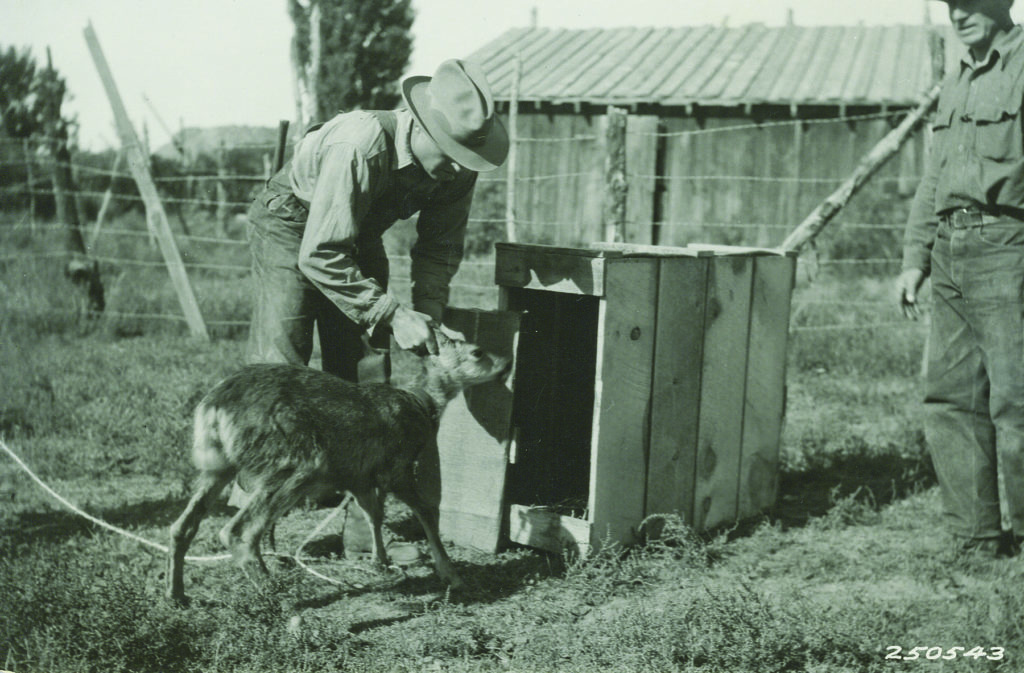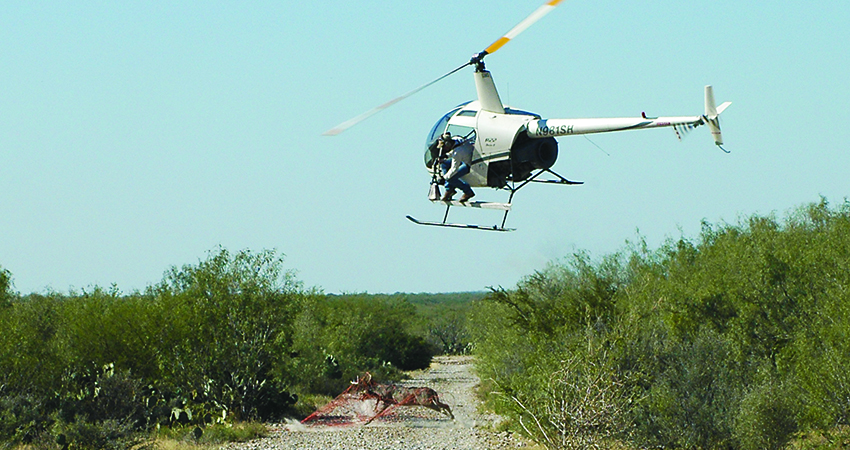D+DH In-Depth is our premium, comprehensive corner on America’s No. 1 game animal. In this graduate-level course, we’ll teach you about deer biology, behavior, and ultimately, how to become a better hunter. Want to be the first to get our premium content? Become a D+DH Insider for FREE!
Translocating big game animals is a common technique that has been used to restore and manage wildlife populations just about everywhere. Wildlife managers sometimes move animals from areas of high density to relieve over-crowding at the source location or restore populations in sparsely populated suitable habitat elsewhere. There are even recent discussions of moving some individuals among populations to simulate the interchange of genes that have now been cut off by highways, fences and urban development.
Capturing deer is most efficiently done with some sort of net, but individual deer can also be captured and moved. Typical capture tools for translocation include drop nets, helicopter drive nets or net guns. Drop nets are suspended like a canopy over a bait pile and then dropped on a group of deer. This method is popular because of its potential to capture many deer at one time, making it very efficient. Individual deer can also be captured by darting with a tranquilizer gun or implementing a walk-in box trap usually referred to as a clover trap.
Most people are familiar with the plight of North American wildlife populations by the late 1800s, well before the advent of widespread conservation laws to restrict harvest. All species that were delicious and wrapped in leather were being killed at rates far exceeding sustainable levels to feed and clothe our growing nation. The white-tailed deer that is so abundant today was a rare species at that time. Teddy Roosevelt and many others led the charge to implement restrictive protective laws and fostered a growing conservation ethic among the population. As we curbed the unregulated killing, we also started to do what we could to bring these wildlife species back from almost losing them forever.
Historical Whitetail Translocations
When we talk about whitetail translocations we normally think of biologists with agency patches on their shoulders loading deer in crates and trailers, but moving deer is far from a new idea. Prior to 500 A.D., there is no archaeological evidence of deer on the island of Curacao, off Venezuela’s coast. However, sometime after that Caquetio natives moved to the island and moved deer with them because when the Spaniards arrived on the island in 1499 white-tailed deer were common.
The Spaniards noted that Caquetios traded venison and live deer between Venezuela and the islands prior to European contact. Caquetios transporting live deer in wooden canoes across more than 20 miles of open ocean is the earliest known deer translocation effort. It should humble biologists to know natives with face paint rather than shoulder patches were translocating deer successfully more than 1,000 years before modern conservation efforts.

It was not uncommon for early 16th and 17th century pirates and sailors to capture deer and release them on islands that lacked deer. This way, there would be a self-sustaining supply of meat to enjoy with their similarly stashed rum. Christopher Columbus documented and named the U.S. Virgin Islands in 1493, but they were free of deer until a Danish ship captain mentioned five white-tailed deer being released there by 1790. From this nucleus, and maybe more, they proliferated on the island and by the time the United States purchased the Virgin Islands from the Danish in 1917, there were an estimated 3,000 deer well-distributed throughout the island.
These examples of early translocations are historically interesting, but they probably represent only a fraction of the instances of deer being moved around by private individuals before formal conservation and restoration efforts began. As our modern system of conservation gained traction, fledgling wildlife agencies started moving deer from pockets of remnant herds to vacant habitat for restoration purposes. This was a monumental undertaking and an enormous number of deer were translocated throughout their historical range.
An effort to summarize these translocations in the southeastern United States was undertaken by Frank Barick (1951) and Jerry Blackard (1971), who documented movements of deer that would have otherwise been lost to history.
A more comprehensive effort to summarize all translocations range-wide came in 1993 (and updated in 2004) by J. Scott McDonald and Karl Miller at the University of Georgia. This document covered 1878-2004 in great detail and serves as the best source of information for the dizzying amount of deer movements conducted. McDonald and Miller summarized more than 105,592 white-tailed deer released in 30 states over the course of 125+ years.
A total of 35 states (plus Mexico) provided source stock for deer releases in 30 states. Wisconsin, North Carolina, Michigan and Texas provided more deer than most states, indicating these were pockets of relatively abundant deer populations at the time. The states receiving the most deer were Georgia, Louisiana, Mississippi, Pennsylvania, Tennessee, Virginia and West Virginia. Some states translocated only their own deer while others brought in deer from any place they could get them, with 23 states receiving deer from out-of-state sources.
Alabama, Florida, Georgia, Pennsylvania and West Virginia received deer from at least seven different states each! Whitetails originating from 11 separate states were released in Virginia in an effort to restore those populations. Also interesting is the fact that early deer enthusiasts translocated white-tailed deer to faraway places such as New Zealand, Finland, Great Britain, Austria, Czech Republic, Serbia, Croatia, Cuba, Jamaica and the U.S. Virgin Islands, and some of those were very successful.
As is obvious now, white-tailed deer populations were restored throughout their entire range and this stands as one of the most successful wildlife restoration efforts ever conducted. Deer survival and distribution following these releases were not well documented so it is unknown how well these translocated deer survived. Undoubtedly it was a mixed bag, with some faring pretty well in their new haunts and some dying out rapidly due to a variety of stressors to which they were not accustomed. The debate continues by tavern patrons and tenured professors about how much these released deer contributed to the restoration versus the natural recovery of native deer remaining in those areas.
The Effects of Translocations
Enter the geneticists and their rapidly evolving analytical tools that can answer questions we never thought possible. By sampling the DNA of current deer herds, researchers can search for genetic patterns and signatures that tell us something about the history of white-tailed deer recovery in North America. Genetic analysis is not magic, but over the past two decades we have learned a lot about how successful historical whitetail translocations were and how this history relates to current deer herd characteristics.
Starting in the mid-1980s, emerging genetic methods led to evaluations of the deer herds in Tennessee and Arkansas with an emphasis on the effects of translocations. Looking at patterns of genetic diversity in 29 deer populations in Tennessee, they found that populations that were stocked with deer from the same source were more closely related, indicating the history of translocations is still detectable in the gene pool. Likewise, the deer population in Arkansas dropped to possibly 500 animals by 1930, before a relocation program in the 1940s and 1950s brought in 3,122 deer from North Carolina, Texas, Wisconsin and other parts of Arkansas. Genetic analysis in the 1980s concluded the genetic structure of Arkansas’ deer herd was mostly the result of the translocated deer that were released.
More comprehensive work by Paul Leberg and his coworkers followed and covered the southeastern United States. They evaluated genetic structure of 21 populations across six states and concluded historical deer translocations in these states have made genetic contributions that are still detectable today. This means these translocations played a substantial role in the restoration of these populations. The same year (1994), Darrell Ellsworth and his colleagues published a similar paper on their research of genetic patterns in 16 deer herds in Georgia, South Carolina, Alabama and Florida. They concluded that the 5,000+ deer released into those states through restocking programs did not contribute significantly to the genetic makeup of the current deer herds. Thus they concluded the current deer populations mostly recovered from pockets of remnant native deer.
These two very similar studies with opposite results caused a lot of confusion about this topic. Who was right and who was wrong? To their credit, instead of arguing about it, Ellsworth and Leberg joined forces and worked together on a combined re-analysis of both data sets to find the truth. They concluded the differences between their previous results were mostly due to methodology differences and that historical translocations did, in fact, have a substantial and long-lasting effect on the genetic composition of current deer herds. The genetic makeup of deer herds that received animals from elsewhere was definitely altered from the new additions. Other deer herds nearby might not have been significantly affected because of the limited dispersal distance of deer and the lack of population interchange.

More recent genetic work was conducted by Randy DeYoung, Steve Demarais and others, sampling 543 whitetails in 16 Mississippi populations. They used updated DNA analysis tools and confirmed that today’s deer populations were strongly affected by the 2,554 deer released in Mississippi as part of its restocking program. Most of these came from within the state, but six other states also contributed deer, including 358 from Wisconsin and at least 195 from Mexico.
Despite the overall genetic effect of the whitetail translocations, several researchers found evidence that some local translocations were not successful and remnant deer herds naturally repopulated those areas. Generally, managers know that they will lose about half of the deer translocated even under the best conditions. In Mississippi, the data seem to indicate populations stocked with Wisconsin deer might not have contributed much to current deer populations. This makes sense because we know deer from the Midwest have a much higher rate of mortality when exposed to viral diseases common in the South, such as bluetongue and epizootic hemorrhagic disease. However, they did not sample any deer from the source location in Wisconsin. Nathan Boddie and Sabrina McGraw later sampled Wisconsin deer and Georgia deer populations that received Wisconsin deer and those that did not. Their results clearly showed that areas of Georgia receiving Wisconsin deer in 1962 were much more closely related to deer still in Wisconsin than to other Georgia populations not receiving these Northern deer. Wisconsin deer did survive to contribute to today’s deer herds, but their effect is localized to the areas where they were released, and even after 50+ years they have not significantly affected native Georgia deer populations as close as 50 miles away.
Genetic evidence of translocated deer is one thing, but how does all of this relate to anything noticeable on the ground? One interesting connection that has just come to light is the relationship between brain abscesses in bucks and past translocation history. Brain abscesses are infections in the brains of mature bucks that start with a head injury and grow to eventually kill the buck. Emily Belser and Bradly Cohen found that the incidence of this disease in Georgia closely matches the areas where Wisconsin deer were released. This disease is present in the source population still today and evidently was brought to Georgia with those translocations.
Ghosts: Past, Present and Future
Some Southern states have areas close to one another with very different rutting dates. Could this be the ghost of translocations past? Jason Sumners and other researchers found that populations with very different rut peaks were also very different genetically, but those with nearly the same breeding season timing were more similar genetically. It was not possible to prove this was due to different source stocks of deer from diverse places, but we know breeding dates are genetically programmed. Sumners thought the most logical explanation was that different rut peaks were from the different sources of translocated deer.
Despite the genetic signatures detected in Southeastern herds, deer generally adapt or die in their new location and we shouldn’t expect to see very different-looking deer. Environmental influences such as nutrition are a very important over-riding factor in a deer’s physical characteristics. For example, researchers in Mississippi compared bucks in areas of the state with different soils and forage quality. They found body and antler size were related to deer nutrition and not the source of the translocations. Still, managers have to consider the potential unintended consequences of translocations regarding disease susceptibility, direct disease transference, timing of breeding and fawning and dietary preferences.
Evidence that these restocking efforts were successful in many places makes us wonder about what we call subspecies. If there ever were legitimate subspecies of whitetails, they certainly don’t exist in the areas where thousands of deer were released on top of hundreds of native deer. There are certainly areas undisturbed by translocations with unique ecotypes of deer such as many Northern deer, Coues’ and Key deer. But past deer movements have to be considered when we talk about classifying “types” of whitetails.
Whitetail translocations have been, and continue to be, an important tool for population restoration and have resulted in amazing success stories for all types of big game animals across the world. It is a tool now used primarily to remove nuisance deer, in part because of its widespread success in the past. Translocations will remain an important tool in the wildlife manager’s toolbox, and we are now able to take advantage of a growing body of information about past actions that will help guide us in the future. We know that moving deer and other animals has the potential to alter the gene pool of the population they are added to, but this might not be something that is noticed from a treestand.
— Jim Heffelfinger is a certified wildlife biologist who has authored or co-authored more than 200 magazine articles, scientific papers and book chapters in national, international and regional publications. He is an adjunct professor at the University of Arizona, Professional Member of the Boone and Crockett Club, and currently works as Wildlife Science Coordinator for the Arizona Game and Fish Department. For more information from Jim, or to order his book, “Deer of the Southwest,” visit www.DeerNut.com.
Want to be the first to get our premium content? Become a D+DH Insider for FREE!

